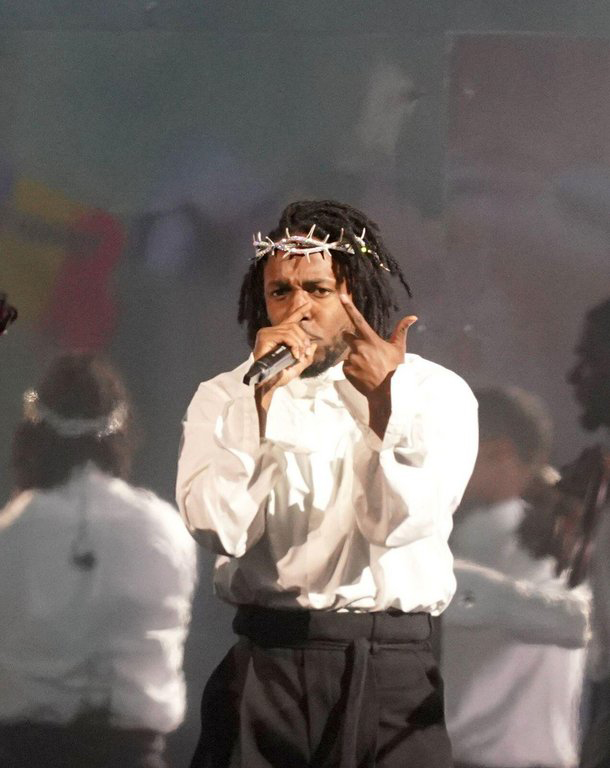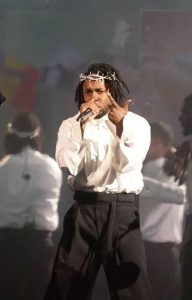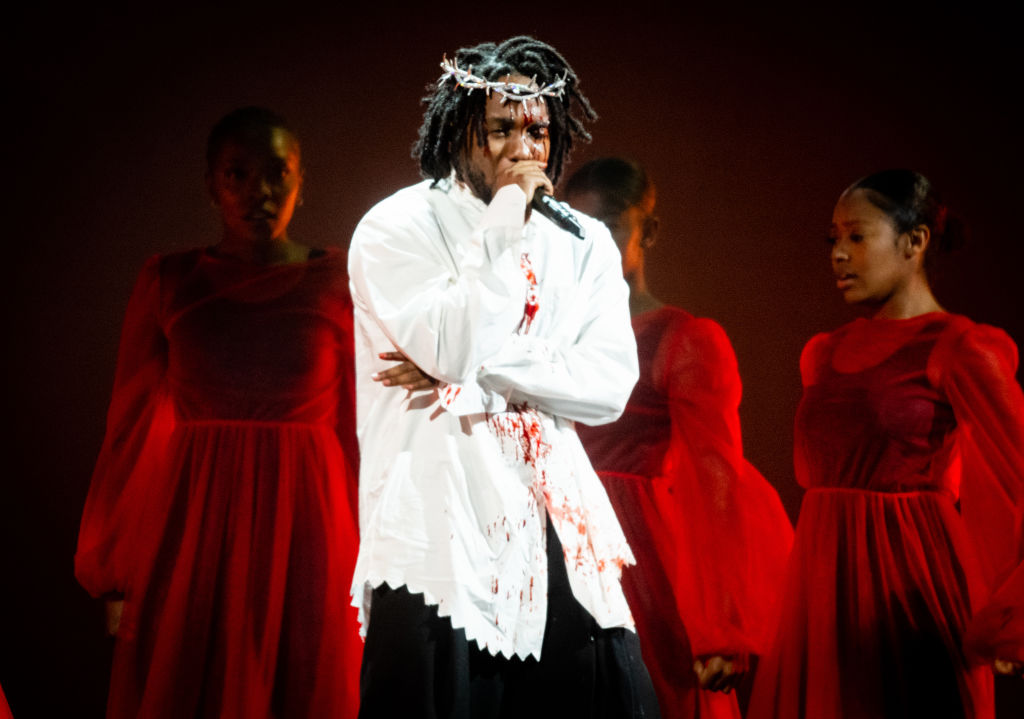2022 Crown of Thorns by Kendrick Lamar and Tiffany & Co.

Religion: Christianity
Time Period: 2020s
Type Of Garment: Headpiece
Tags: Crown of Thorns, High Fashion, Hip Hop, Jesus, Tiffany & Co, United States
The Object and Creator:
At the 2022 Glastonbury Music Festival, rapper Kendrick Lamar performed wearing a billowy white shirt and wide-legged black pants designed by Louis Vuitton, a sophisticated, yet subdued outfit that highlighted his sartorial pièce de résistance–a crown of thorns by renowned luxury jeweler Tiffany (Maoui 2022). Made of high-polished titanium and embellished with approximately 8000 diamonds, the equivalent of 137 carats, the crown features 50 thorns of varying lengths and widths (Tiffany & Co. 2022). The elaborate headpiece took 10 months and over 1300 hours to create and cost approximately three million dollars (Archive Threads 2022).
Tiffany has long been an icon in the American jewelry scene. The first Tiffany & Co. store opened in 1837, and since that time the company has grown in power and influence. Having worked with a range of high-profile clients from politics (President Abraham Lincoln), film (Audrey Hepburn), and music (Beyoncé), the company has become the premier destination for diamonds and luxury pieces (“The Tiffany & Co. Timeline”). While known for catering to an elite clientele, the “Tiffany” name and brand has captured the imagination of the average person, whether it evokes images of Hepburn in Breakfast at Tiffany’s, the iconic “Return To Tiffany’s” heart jewelry, or aspirational visions of Tiffany blue gift boxes. The brand holds an enduring place in 21st century American culture, for average consumers, wealthy customers, and celebrity clients.

While actresses wear Tiffany jewelry to various awards shows and the brand sponsored Beyoncé’s Renaissance Tour in 2023, celebrity commissions and collaborations, on the scale of the crown of thorns, are more rare. According to Tiffany’s Press Release, this venture highlighted the brand’s signature qualities and artistry. “‘Kendrick Lamar represents the artistry, risk-taking creativity and relentless innovation that has also defined Tiffany & Co. for nearly two centuries,’ says Alexandre Arnault, Executive Vice President, Product and Communication, Tiffany & Co”(2022).
For Kendrick Lamar and Dave Free (a high school friend, the former president of Top Dawg Entertainment, and co-founder of their “multi-disciplinary creative services company” PgLang), this commission was the latest in a long line of creative endeavors (Olunkwa). According to Free, the crown is “a godly representation of hood philosophies told from a digestible youthful lens,” as well as a nod of respect to the artists who came before him (McDermott 2022). The crown also celebrated Lamar’s fifth studio album Mr. Morale and the Big Steppers released by Top Dawg and PgLang. On the cover to the album, Lamar wears the crown while holding a young child and the crown itself is engraved with the words “Mr. Morale.” The crown not only commemorates “hood philosophies” and the album, but also in working with such an iconic brand, Lamar highlights his status with the imprimatur of Tiffany’s name and legacy.
The Wearer:
Kendrick Lamar (b. 1987) is one of the most influential and award-winning hip hop artists in the United States, if not the world. In 2018, he won the Pulitzer Prize for Music, and he has also earned 17 Grammys, 11 MTV Video Music Awards, 4 American Music Awards, 37 BET Hip Hop Music Awards, and numerous others. His fame is such that in 2016 TIME magazine named him one of the one hundred most influential people. Personally, Lamar identifies as Christian, having converted as a teenager after the death of a friend, and Christian themes appear in his songs, though they are rarely the primary theme (Relevant 2015). For example, in songs such as “Faith,” Lamar discusses the struggles that come with maintaining faith in God amidst the challenges of life, and “Sherane a.k.a. Master Splinter’s Daughter” begins with a sinner’s prayer and proclamation of belief in Jesus before chronicling an intimate relationship with the sexy “Sherane” (Zanfagna 2017, 201, 141; Lamar).
Two tracks from Mr. Morale & the Big Steppers explicitly invoke themes that help contextualize Lamar’s crown of thorns–“Crown” and “Savior.” In “Crown,” Lamar laments his inability to please others, while emphasizing “heavy is the head that chose to wear the crown, to whom its given, much is required now”(Duval, et al). Despite privilege and praise, peace remains elusive. And when Lamar wore the diamond encrusted crown of thorns at Glastonbury, his set included “Savior,” his favorite track from the album and a song infused with theological questions and paradoxes.
Kendrick made you think about it, but he is not your savior
Cole made you feel empower, but he is not your savior
Future said “Get a money counter”, but he is not your savior
‘Bron made you give his flowers, but he is not your savior
He is not your savior
While performing, Lamar denied his savior status, a fact emphasized by projecting “Your Savior I Am Not”on the screens behind him, but he did so wearing a symbol of Jesus as fake blood dripped down his head. And as the set ended he repeated the refrain, “They judge you, they judge Christ. Godspeed for women’s rights!” to protest the U.S. Supreme Court’s overturning of Roe v. Wade days earlier (McDermott 2022; Clarke 2022; Thompson 2022).

The Context:
In the New Testament of the Christian Bible, Roman soldiers create and place the crown of thorns on Jesus before his crucifixion (Matthew 27:27-29; John 19: 1-3; Mark 15: 16-18). They utilized it to mock Jesus as the King of the Jews and inflict pain prior to his death as a criminal (Nickell 2007, 74). In the history of Christianity, the crown of thorns symbolizes Jesus’ suffering and sacrifice–the burden he carried for others. It highlights the depth of his love for humanity (Heiberg 2007; see Figure 3).

Lamar’s wearing of a crown of thorns is not surprising when we consider religion’s relationship with rap music. According to scholar Anthony Pinn, “there is no clear distinction between the sacred and the secular; they flow together, merging in unexpected places” (Pinn 2003, 21). Historically, rap has included a wide variety of topics, and religion is no exception. This makes even more sense when you consider how religion functions as a response to challenges of life and forms of cultural production (Pinn 2003, 87). However, there is an interesting comparison to be drawn between the works of “Christian” rappers, such as L.G. Wise, and rappers who are “Christian,” such as Lamar. Christian rappers focus on the perfection of Jesus Christ and how belief in Him will lead to salvation, ideas rooted in evangelical forms of Christianity (Pinn 2003, 39). In sharp contrast, Lamar, Mr. Morale and the Big Steppers, and the song “Savior” highlights themes of imperfection and his music emphasizes the difficulties of living a Christian life (McDermott 2022).
Lamar’s repetition of “they judge you, they judge Christ” is particularly poignant when you consider Lamar’s position as a Black man, a rapper, and a celebrity figure. Lamar, along with many other Black men, faces the burden of racist judgments and stereotypes, including being violent and sexist. These racialized stereotypes are amplified by superficial and outsider perceptions of rap music and rappers. Lamar’s Glastonbury performance and his powerful statement provide a deep contrast to these stereotypes. Here, he takes a stand against these perceptions of himself, as well as the limitations placed on women and their reproductive rights in the U.S. Finally, Lamar’s position as a celebrity also deserves consideration. In many ways, there are parallels between fandom and Christianity. Lamar wearing this crown as a celebrity figure with a base of followers almost positions him in a Christ-like manner: he may not be Jesus and he may not be a savior, but he preaches a gospel to a crowd of followers while carrying his own burdens.
Katherine Claybrook, Religious Studies Major with a Double Minor in Arabic and Middle Eastern and South Asian Studies (WFU ‘26).
3 October 2024
Tags: Crown of Thorns, High Fashion, Hip Hop, Jesus, Tiffany & Co., United States
References:
Clarke, Naomi. 2022. “Kendrick Lamar Closes Glastonbury with a Powerful Call for Women’s Rights.” The Independent, June 26. Available at: https://www.the-independent.com/news/uk/kendrick-lamar-glastonbury-diana-ross-paul-mccartney-elbow-b2109923.html.
Duval, Timothy, Kendrick Lamar Duckworth, and Sam Dew. “Crown.” Lyrics.
Heiberg, Jeanne. 2007. “Symbol Talk: The Crown of Thorns.” Catechist 02: 46–49.
Archive Threads. 2022. “Is Kendrick Lamar’s $3M Diamond ‘Crown of Thorns’ Sacrilegious or a Holy Grail?” Available at: https://www.archivethreads.ca/post/is-kendrick-lamar-s-3m-diamond-crown-of-thorns-sacrilegious-or-a-holy-grail.
Relevant Magazine. 2015. “Kendrick Lamar: ‘All I Am Is a Vessel, Doing His Work.'” Available at: https://relevantmagazine.com/culture/kendrick-lamar-all-i-am-vessel-doing-his-work/.
Maoui, Zak. 2022. “How Kendrick Lamar’s Glastonbury Fit Played a Vital Role in His Mind-Blowing Performance.” GQ, June 27. Available at: https://www.gq-magazine.co.uk/fashion/article/kendrick-lamar-glastonbury-crown-tiffany.
McDermott, Kerry. 2022. “The Story Behind Kendrick Lamar’s Crown of (Tiffany & Co.) Thorns.” Vogue. Available at: https://www.vogue.com/article/kendrick-lamar-crown-of-thorns-tiffany-co.
Nickell, Joe. 2007. Relics of the Christ. Lexington: University Press of Kentucky.
Olunkwa, Emmanuel. “New Lingo: An Interview with Dave Free.” PIN–UP Magazine. Available at: https://www.pinupmagazine.org/articles/dave-free-interview.
Pinn, Anthony B., ed. 2003. Noise and Spirit: The Religious and Spiritual Sensibilities of Rap Music. New York: New York University Press.
Tiffany. 2022. “Tiffany & Co. Creates Custom ‘Crown of Thorns’ with Artist Kendrick Lamar.” Tiffany. Available at: https://press.tiffany.com/tiffany-co-creates-custom-crown-of-thorns-with-artist-kendrick-lamar/.
Lamar, Kendrick. “Sherane a.k.a. Master Splinter’s Daughter.” AZ Lyrics.com.
Tiffany. n.d. “The Tiffany & Co. Timeline.” Accessed October 2, 2024. https://www.tiffany.com/world-of-tiffany/the-world-of-tiffany-timeline/.
Thompson, Isaiah. 2022. “Kendrick Lamar & His Crown of Thorns: Breaking Down the Problematic, the Performative & Theology.” Rapzilla, July 2. Available at: https://rapzilla.com/2022-07-kendrick-lamar-crown-thorns-theology/.
Zanfagna, Christina. 2017. “Roads to Zion: Hip Hop’s Search for the City Yet to Come.” In Holy Hip Hop in the City of Angels, 128–44. N.p.: University of California Press. http://www.jstor.org/stable/10.1525/j.ctt1w8h1sj.8.
